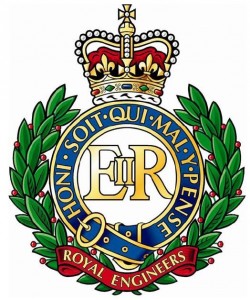
Royal Engineers Cap Badge, as of 1900. Image available in the public domain via Wikimedia Commons.
The wonderful blog The Long, Long Trail: The British Army in the Great War of 1914-1918 has posted an article on British Army minimum daily rates of pay in 1914 and 1915, as defined by War Office Instruction 166 (1914). These rates were later revised in December 1915.
Daily rates of pay are divided into Officers and Warrant Officers, NCOs and men and are divided according to Corps.
In both categories – Offices and Warrant Officers, NCOs and men – the Royal Engineers (which then incorporated the Signals Service) were amongst the best paid men in the British Army in 1914 and 1915, particularly at the more junior officer rank levels. Officers in the Royal Engineers shared the same basic minimum daily rate of pay as other corps but were awarded “Engineers Pay” which was an additional payment of between 20-50% of their baseline pay. In addition to their basic pay and additional “Engineers Pay”, Second Lieutenants could be awarded a further 1s 6d if they were certified by their Commanding Officer as to their technical efficiency.
Table of Officers’ daily rates of pay by rank and by corps (excluding the Royal Flying Corps)
These are the minimum daily rates of pay for typical ranks or appointments of all arms. All rates in Shillings (s) and Pence (d).
| Cavalry of the Line, Irish Horse, King Edward’s Horse and Yeomanry | Royal Horse Artillery | Royal Field Artillery and Mountain Artillery | Royal Garrison Artillerya | Royal Engineersb | Infantry | Army Service Corpsc | Royal Army Medical Corps | Army Veterinary Corps | |
| Lieutenant-Colonel | 29s 6d | 29s 9d | 28s 0d | 29s 6d 24s 6d |
35s 0d 21s 0d |
28s 0d | 27s 0d 21s 0d |
30s 0d | 30s 0d |
| Major | 17s 0d | 18s 6d | 16s 0d | 19s 6d 16s 0d |
25s 0d 16s 0d |
16s 0d | 19s 0d 15s 0d |
23s 6d | 20s 0d |
| Captain | 13s 6d | 15s 0d | 13s 6d | 15s 6d 13s 6d |
17s 6d 13s 6d |
12s 6d | 15s 6d 12s 6d |
15s 6d | 15s 6d |
| Lieutenant | 9s 6d | 10s 6d | 9s 6d | 10s 6d 9s 6d |
12s 6d 9s 6d |
8s 6d | 11s 6d 8s 6d |
24s 0dd 14s 0d |
13s 8d |
| Second Lieutenant | 8s 6d | 9s 6d | 8s 6d | 9s 6d 8s 6d |
11s 0d 9s 6d 8s 6d |
7s 6d | 10s 6d 7s 6d |
N/A | 11s 6d |
| Quartermaster | 11s 6d | 11s 6d | 10s 6d | 10s 6d 10s 6d |
12s 6d 10s 6d |
10s 0d | 10s 6d 10s 6d |
10s 6d | 30s 0d |
a The figure in bold for the Royal Garrison Artillery includes Armament Pay which was payable only if certified by Commanding Officer with regard to the Second Lieutenant’s technical efficiency.
b The figure in bold for the Royal Engineers includes Engineer Pay and in the case of the Second Lieutenant the higher figure in bold and italics also includes a further 1s 6d payable only if certified by Commanding Officer with regard to the Second Lieutenant’s technical efficiency.
c The figure in bold for the Army Service Corps includes Corps Pay
d Temporary Lieutenants in the Royal Army Medical Corps serving under civil contracts receive 24s 0d per day
As can be seen by this table above, the Royal Engineers’ rates of pay (marked in red) were some of the highest across the different corps and different ranks. They were comparable with those of another technical occupation, that of the Royal Flying Corps which has been omitted as their ranks do not necessarily map readily onto those of the other Army corps at this time.
The high rates of daily pay offered to the Royal Engineers and indeed to some other Army corps show the financial value and importance of technical and specialist expertise to the British Army in the early stages of the First World War. Further to this, these figures also offer a fascinating comparison of the importance and value of engineers, especially younger officers with technical expertise, in the British Army at the start of the First World War.
See British Army 1914 rates of pay for the minimum daily rates of pay for the different corps of the British Army in 1914 and 1915.
UPDATE: For an excellent overview of the Royal Engineers between 1914 and 1918, see The Long, Long Trail: The Royal Engineers of 1914-1918.
About the author: Dr Elizabeth Bruton is postdoctoral researcher for “Innovating in Combat”. See her Academia.edu profile for further details.
